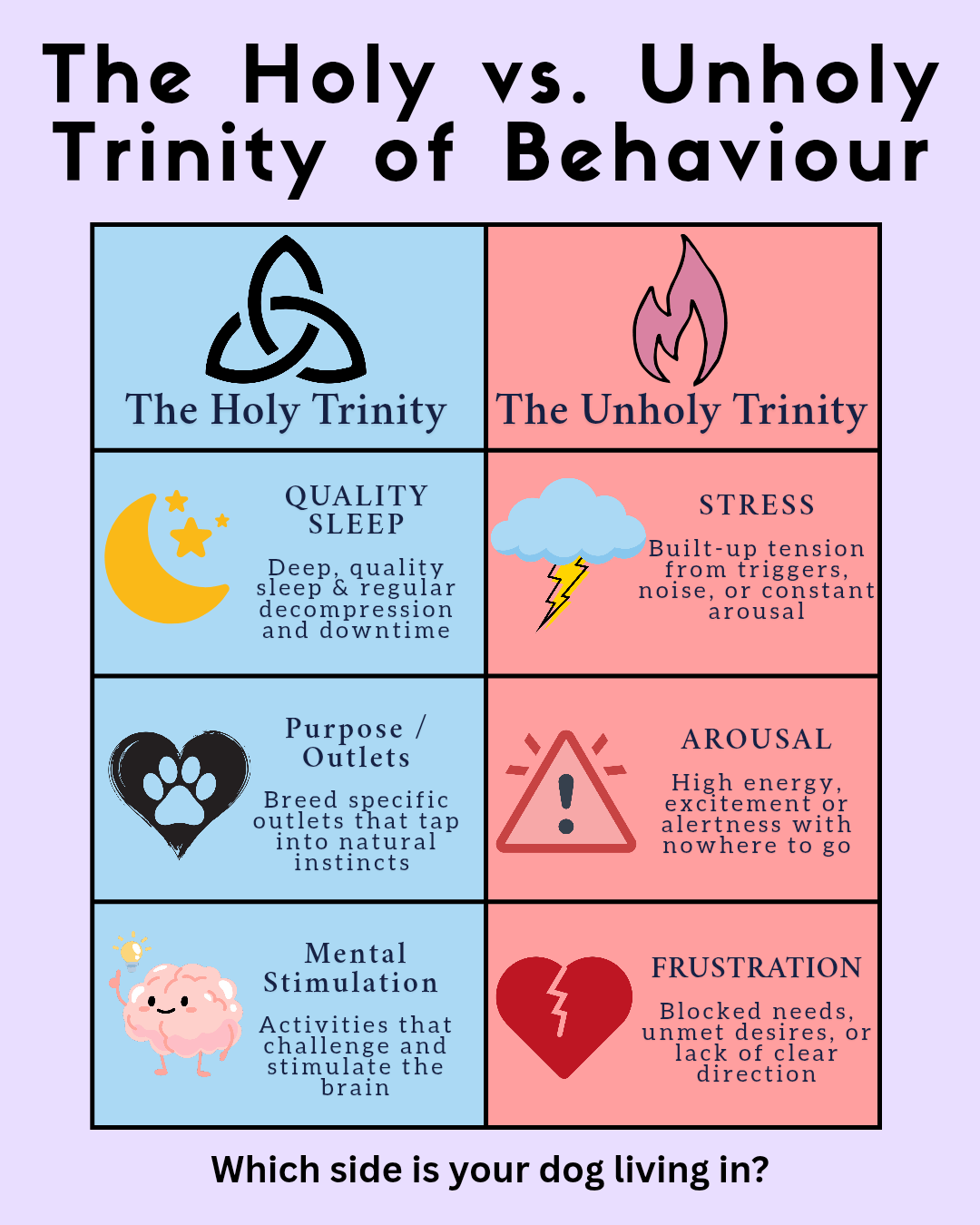Dog Gets Overstimulated on Walks? Here’s Why + What To Do
If your dog gets overstimulated on walks, you're not imagining it. They pull harder. React faster. Seem wired afterwards instead of relaxed. And despite your best efforts, the walks that were supposed to help them blow off steam are just making things worse.
You’re not doing anything wrong — but something isn’t working, but there are steps you can take to help your dog reset and enjoy walks to the fullest again!
Let’s break down why this happens and what to do when walks become a little more of a...chaotic experience.

What Is Overstimulation in Dogs?
Let’s start with the basics — a stimulus is anything that triggers a change in your dog’s body or their behaviour. It could be a sound, a smell, movement, or even something like a shift in energy.
Overstimulation happens when your dog is exposed to too many of these stimuli at once, or over a short period of time. This can create an overexcited and overwhelmed dog. Without proper regulation or decompression they can become stuck in a heightened state of stress. Their system becomes flooded, and they struggle to process or respond calmly.
Some dogs can handle a lot going on around them. Others get overwhelmed quickly and struggle with regulation, and when that happens, it often shows up in their body language and behaviour.

What Does Overstimulation on Walks Look Like?
When dogs are out walking, they’re surrounded by sights, sounds, smells, and movement — all of which act as stimuli. For some dogs, this can become overwhelming fast, especially out in new environments, around new people or if they’re already been carrying stress or arousal from earlier in the day.
I call it “squirrely behaviour” (others call is hypervigilance); that shifty, alert, high-energy state where they’re constantly scanning, tense, anticipating, reacting, and unable to settle.
It’s not always obvious, but here are some common signs:
Pulling like a maniac
Frantic sniffing or zig-zagging
Barking at everything (or nothing)
Jumping up, lunging
Struggling to take treats
Coming home more restless than before
Tense or stiff body language
Hyper-focused staring
Sudden jumpiness
Difficulty responding to cues

Why Dogs Get Overstimulated on Walks
Meet The Unoly Trinity (The Cause)
There are a few different reasons this happens, and it often comes down to a mix of silent internal pressures.
Enter what I call the Unholy Trinity:
Stress (carried over from previous triggers or days)
Arousal (hyped-up energy with nowhere to go)
Frustration (being restrained or unable to chase, sniff, play, etc.)
This combo pushes your dog into overdrive, which if not deal with can build up and become more impulsive and unpredictable.

Meet the Holy Trinity (The Antidote)
If the unholy trinity of behaviour is stress, arousal and frustration, then what is the holy trinity? The foundation that helps dogs regulate, recharge, and reset. I call it the Holy Trinity because these three things when done right can transform behaviour from the inside out:
Rest — not just sleep, but real downtime and structure that helps a dog learn to switch off. Rest is where regulation happens.
Purposeful outlets — chewing, sniffing, digging etc. Dogs need a job that challanges them and taps into their instincts.
Mental stimulation — problem-solving games, scent work, and challanges that engage the brain without adding chaos.
These three elements work together to lower your dog’s stress baseline, making it easier for them to stay calm, learn, and make better decisions — on walks, at home, and everywhere in between.

Why Constant Overstimulation In Dogs Is A Problem
When dogs are constantly overstimulated without regulation, they become stuck in a heightened state of arousal and that’s exhausting, both mentally and physically. It’s like their nervous system is constantly firing and everything just gets overwhelming. Over time, this can lead to reactivity, anxiety, and trouble settling, even in calm environments.
Think of it like...
You know how for some people, opening an email inbox feels like opening a door to a tiger? Heart racing, tense shoulder, short breathes, brain firing warnings...
Now imagine that feeling...every single time you go for a walk. That’s overstimulation for a lot of dogs.
When stress builds, it doesn’t just disappear. It sits in the body, bubbling under the surface. That’s when we start to see an over excited dog on walks and unpredicatable behaviour like constant barking, reactivity, hyper-vigilance, and even snapping and biting.
A Reset Might Be Exactly What Your Dog (+ You) Needs
If every walk feels like a battle, if your dog is constantly overstimulated, if they struggle to switch off even after "tiring them out"…
You're not missing a trick — you're stuck in a loop. And your dog probably is too.
This kind of constant overstimulation doesn’t go away with more walks or stricter obedience drills.
What you need is a reset. A moment to pause. To take a breath. To start again from a level playing field with intention.
That’s exactly why I created the Paws Of Wisdom Detox Protocol — firstly to help my dog have the foundation to reset — but now to help others do the same. This is just a simple, step-by-step plan to help you hit pause on the chaos, meet your dog’s needs, and finally build that sense of calm that's been missing recently.
If your dog’s nervous system is stuck in overdrive, and you feel like nothing is working, then maybe what you need is an intentional break...
Start your Detox today — and watch what changes when you meet your dog where they really are!
How to Set Your Dog Up for Success on Walks
Meet their needs before the walk (outlets, structure, decompression)
Keep walks short, quiet, and structured
Avoid triggers if you must
Avoid walks if you must
Use food to create focus (scatter feeding, pattern games, etc.)
Don’t be afraid to end early and turn back
Celebrate the small wins
Allow your dog the time for decompression if needed
Set boundaries and expectations for the walk
Build engagement, predictability, confidence and trust in quiet areas with little to no distractions
A shorter, calmer walk is always better than a longer, chaotic one.
Are Your Walks Doing More Harm Than Good?
If every walk feels like a battle, it might be time to pause. Not forever — but long enough to reset the system.
Now a common myth is that we have to walk our dogs everyday, but what they don't tell you is that if every walk is a stress-filled chaos fest, and you can find alternatives — that's okay. If fact, a lot of owners who have opted for meeting their dogs needs through different methods often enjoy it more.
Many owners make the mistake of relying on walks as their source of exercise, but more walks just means more exposure to stress, triggers, and frustration. If your dog is constantly coming home more wired than they left, walking might be what is keeping them stuck in a stress loop.
Final Thoughts
If your dog constantly gets overstimulated on walks and struggles with self-regulation, it’s usually a signal that they need more support.
When we focus on meeting their core needs — rest, outlets, and mental stimulation — everything starts to shift. Walks become smoother...triggers feel less explosive...and your dog starts to feel more in control of themselves and their environment. Add in some structure, boundaries and expectations and you can build a beautiful foundation with your dog.
Frequently Asked Questions (FAQs): Overstimulated Dog On Walks
Walks can be sensory overload — smells, sounds, movement, other dogs, people — and for some dogs, it’s simply too much. Making them impulsive, hyperactive and unpredictable.
Before the walk start with structure and calming activities like scatter feeding in the garden or some leash drills before the walk. On the walk, keep things short and structured. Use food for focus, avoid overwhelming environments and situations, and don’t be afraid to turn back.
Signs include: pulling, barking, frantic sniffing, jumping, lunging, ignoring food, struggling to respond to cues and more. Overstimulation often looks like excitement or frustration but builds quickly and doesn’t come down easily.
Hypervigilance is often a sign that your dog doesn’t feel safe or is anticipating something. It can stem from stress, anxiety, or previous negative experiences. Helping your dog feel secure, decompress regularly, and walking in quieter areas can really help.
Related Reading
A FREE community with downloadable guides and resources, and people who get it.
A simple and structured reset for overstimulated, dysregulated, chaotic dogs.
Simple, clear guidance to help you understand your dog through a regulation-first lens.









